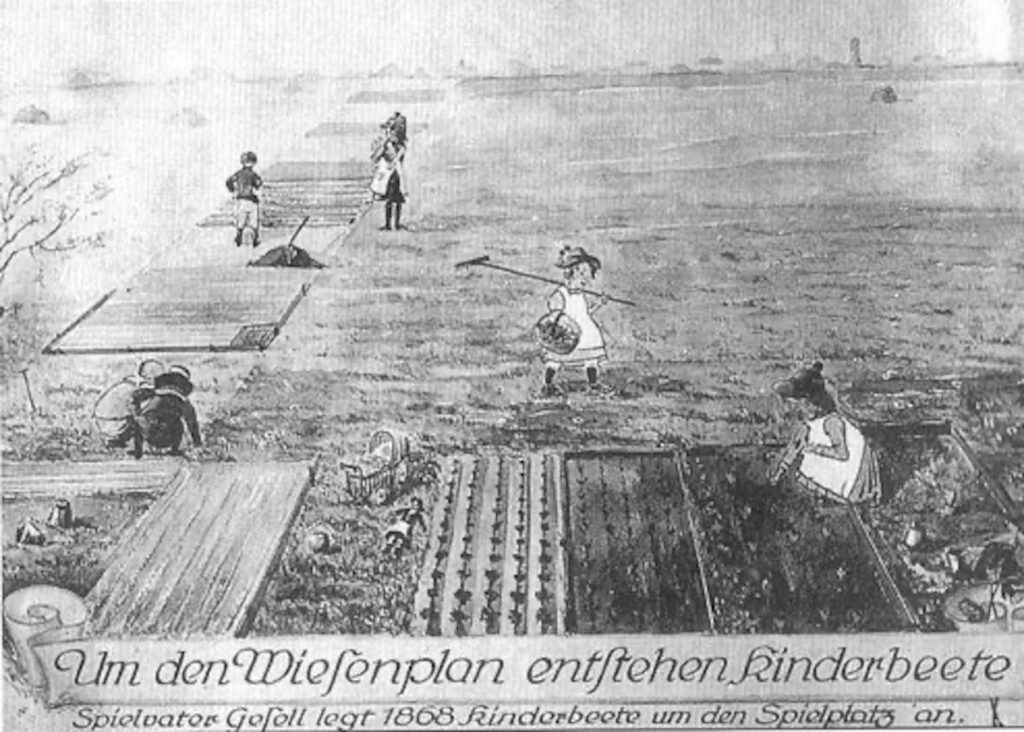Both, Berlin and Warsaw were severely damaged during World War II. Deprived of a concentric structure with a clearly defined centre, marked by variability of subsequent layers –architectural, cultural and social. This is of great importance in today’s arrangement of allotment gardens, often located on wasteland, post-fortress or railway areas (Biegański 2015). In both cities, numerous allotment gardens have a long tradition. For the comparison of allotment gardens in Warsaw and Berlin, important information is provided by the shape of the spatial and demographic structure in the post-war period, resulting from political and ideological factors (division of Germany, People’s Republic of Poland). The new residents settled en masse in the capital city for profit or education, and they were mainly people from small towns or rural areas, constituting a rather homogenous social group with a lower level of education. This period saw the intensive development of Workers’ Allotment Gardens (Pracownicze Ogródki Działkowe) in the People’s Republic of Poland and Kleingärten in the GDR, which served mainly for the working class. The gardens often provided food in times of crisis (Pawlikowska-Piechotka, 2009) or cheap weekend rest or “paradise on earth for the lower class” (Gaus, 1983). This has a significant impact on today’s social structure of allotment gardens, as almost half of plots users are people in retirement age (PZD data, 2016) which might be one of the reasons for inaccessibility and illusive closure of garden colonies to a diverse group of people.
Currently, the problem of dynamic growth affects large cities around the world. Every year, thousands of new residents come to Warsaw and Berlin (in 2017 respectively 19,500 and 40,000, Kleine Berlin-Statistik, GUS, 2018), which increases the demand for housing (Wolff et al., 2016). In this situation, forms of urban development such as gardens, which lack strong lobbying, attract the attention of investors and urban planners, being a potential development area (London Assembly, 2018; Morgenpost 2017). Increasing demand in the real estate market is putting pressure on less lucrative land in the city often occupied by gardens (COST Action on Allotment Gardens; Factsheet 01). Urban space is treated as a commodity, subject to free market rules, which means that greenery in the city must compete in the capitalist city planning system (Stellmacher, Brecht, 2017, Pobłocki et al., 2013). Community gardens are often built on wasteland (ger. Brache) which will most probably be used for development (Müller, 2017). They often have forms of temporary land use, making them difficult to achieve stability of their functioning and continuity of projects carried out.
For quite different reasons, but with the same result, allotment gardens are fighting for their survival in the city (Szczepańska et al. 2016). Originally built in the suburbs, now they are often found located in urban areas due to city growth. High demand on land within cities, the globalized food industry as well as lack of social policy in the management of the gardens, causes the gradual liquidation of allotments in European cities (London Assembly, 2018). Gardens are often being transformed into recreational areas or give way for new development and transport infrastructure as part of the current urbanization trend (United Nations, 2017, 2015). They are often perceived by younger generation as unattractive and old-fashioned and an orderly, monotonous structure consisting of almost identical parcels often does not provide an interesting space for young people. Additionally, private and individual use of the plots limits social contacts in the allotment gardens, and thus reduces their social function, which used to be an important element of allotments in the beginning in Schreber Gardens. Equipped with common areas, playgrounds for children, experimental vegetable gardens served a wider group of people, like today’s community gardens.
The pre-war model of gardens-parks, established in 1926 in Nuremberg, assumed the creation of green areas extended by areas accessible to all residents, equipped with wide alleys with benches, meadows and playgrounds for children. Their social functions were fulfilled by frequency of interactions and practices (f. e. gardening) of their users and social relations were produced in shared space inside the gardens. This model, which worked well in the gardens of Berlin and Warsaw as well as Breslau, Łódź, Leipzig, Vienna is less frequently practised in the last 20 years. Today gardens are often locked with a padlock, raising residents’ distrust. In contrast to newer community gardens, allotment gardens are rather closed greenery strongholds in cities, intended only for the few.

References:
Biegański, L. (2015) Czy ogrody działkowe powinny być tematem polityki zagospodarowania przestrzennego? in: Ogród za oknem. Przyszłość ogrodów działkowych, Monografia. Sztuka krajobrazu nr 3, red. Gawryszewska, B., Warszawa
COST Action on Allotment Gardens; Factsheet 01
Gaus G. (1983) Wo Deutschland liegt: Hamburg: Hoffman und Campe
GUS (2017) Ludność. Stan i struktura w przekroju terytorialnym
Kleingarten in Berlin. Kleingartenentwicklungsplan Berlin 2030, Entwurf (2019)
Pobłocki K., Mergler L., Wudarski M. (2013) Anty-bezradnik przestrzenny: prawo do miasta w działaniu, Fundacja Res Publica
Polski Związek Działkowców / Polish Allotment Gardens Association, 2018
Stellmacher, M., Brecht, N. (2017) Recht auf Stadt: Degrowth in Boomtowns oder das gute Leben in der Stadt für alle, in: Degrowth in Bewegung(en), oekom Verlag, München
